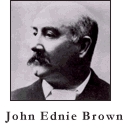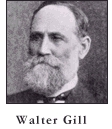South Australia’s first Conservator of Forests, Scottish-born John Ednie Brown, arrived in Adelaide on 16 September 1878 to begin his new role in a very foreign land.
Just a week later her he was headed north to inspect the first trial plantings at Bundaleer and Wirrabara, which signalled the beginning of forestry in South Australia and in fact the whole of Australia.
 By April the following year he had made further visits to the northern reserves as well as having sailed to MacDonnell Bay, visited the reserves in the Green Triangle and travelled home by coach.
By April the following year he had made further visits to the northern reserves as well as having sailed to MacDonnell Bay, visited the reserves in the Green Triangle and travelled home by coach.
His voluminous and meticulous reports attest to his energy and abilities as a writer, and before he resigned in 1890 to go to New South Wales as Director General of Forests, he had published South Australia’s first forest flora and treatise on tree planting as well as numerous detailed reports.
He cast his net widely in his search for useful forestry trees for South Australia, trying species from throughout the world. Unfortunately, his arboricultural background could, in hindsight, be seen to have diverted his energies away from large scale afforestation for commercial purposes which his successor, Walter Gill, took up.
The Conservator clashed with Forestry Board Chairman George Goyder on whether trees increased local precipitation. His efforts to plant up the plains north of Quorn to increase rainfall were publicly supported but strongly opposed by Goyder, who was trying to confine agricultural development south of Goyder’s Line.
Brown’s work as Conservator in protecting what woodland and forest was left, discovering trees that could form the basis of a State Forestry enterprise and raising community awareness of the importance of trees had statewide and lasting benefits.
Walter Gill had shown a childhood interest in botany and when he came to Australia from England in 1876, his interests continued while he worked for John Angas at Mount Remarkable and as Inspector of Crown Lands from 1884. He sent many specimens to Brown, the Conservator of Forests Eucalyptus gillii being named after him.
When a vacancy occurred in the Department in 1886, Mr Brown remembered the enthusiastic Walter Gill and appointed him forester at Wirrabara.
 When Brown moved to New South Wales in 1890, Gill was appointed Conservator. Of radiata, Aleppo and maritime pines Gill believed “there is a wide field for creation of forests of these pines on a very extensive scale and every effort is now (1913) being put forth to create a future supply which will be equal to the demand”.
When Brown moved to New South Wales in 1890, Gill was appointed Conservator. Of radiata, Aleppo and maritime pines Gill believed “there is a wide field for creation of forests of these pines on a very extensive scale and every effort is now (1913) being put forth to create a future supply which will be equal to the demand”.
He is remembered for several major influences on South Australian forestry:
- The development of extensive radiata pine plantations in the Green Triangle.
- Commencement of sawmilling at Wirrabara in 1903.
- Promotion of Pinus radiata, forestry and the operations of the department.
- His photographic skill, recording for posterity the people, the land, its forests and forestry development.
South Australian forestry became an exciting development during Gill’s time as Conservator and he became well known within the community. He retired in December 1923, after 37 years of service.



